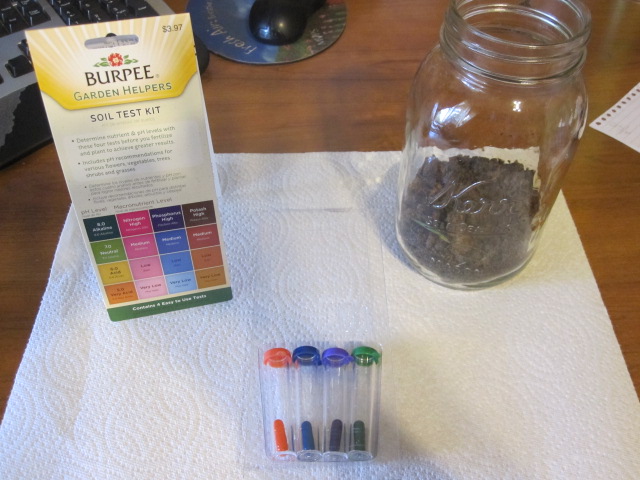I bought an inexpensive Burpee Soil Test Kit from the local hardware store. It looks like a miniature science experiment and somehow intimidates me. It turned out not to be nearly as complicated as I had feared. In fact, not complicated at all.
Here are the steps and what I learned:
- I had to collect soil from four different areas of the yard from about 4-inches below the surface
- For the pH test, I added a small amount of soil to the proper tube
- I added the powder from the green capsule- Added water to the top
- Shook it up
- Compared it to the chart. I have "Neutral" soil! ["The pH level of your soil determines how well your lawn or plants can use nutrients such as nitrogen, phosphorus, and potash (potassium). Some species prefer acidic soil (low pH) while others need alkaline soil (high pH).]
- The next step was to fill the jar of dirt to the top with water, stir it and let it sit for 10 minutes. I added that water to each of these tubes and the contents of their capsules to test for Nitrogen, Phosphorus and Potassium (Potash).
- They had to sit for a few minutes
- I have a medium amount of Potassium, so I'm not going to have to worry about that one. ["Potassium, also known as Potash, increases vegetable and flower production."]
- The color looks a little different on the computer screen, but our Phosphorus levels are low. ["Phosphorus is important for young plants and seedlings, and aids in root development."] An article on eHow tells How to add Potassium to the Soil, and happily I'll be able to use our chicken manure for this!
- Nitrogen is so extremely low that the color barely even registers as pink. (Again, the computer screen makes it look a bit different.) ["Nitrogen is necessary for lush green lawns, and leaf and plant development in both flowers and vegetables. Too much, however, can lead to leafy plants with few flowers and fruits."] An article on Yahoo VOICES tells How to Naturally Add Nitrogen to Your Garden Soil, and happily I'll be able to use the compost from our kitchen scraps for this!
I was pleased to learn that we were already planning on amending our soil in the way it needs to be amended, and that we already have these things on hand and won't have to purchase anything separately!
Have you ever tested your soil and amended it depending on the results? Please share your experience below!
[Quotes defining the elements were taken from the Burpee Soil Test Kit package.]











No comments:
Post a Comment